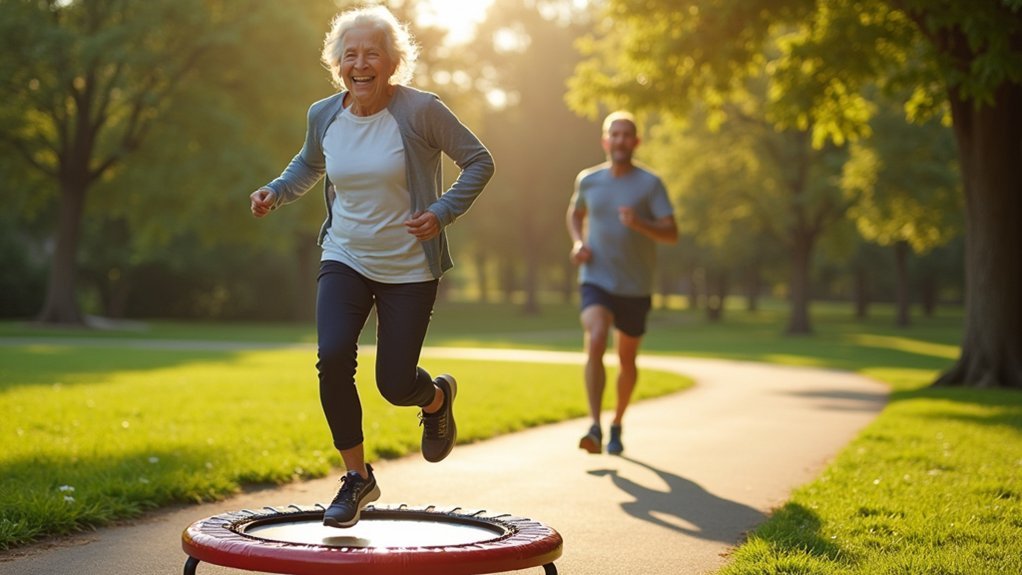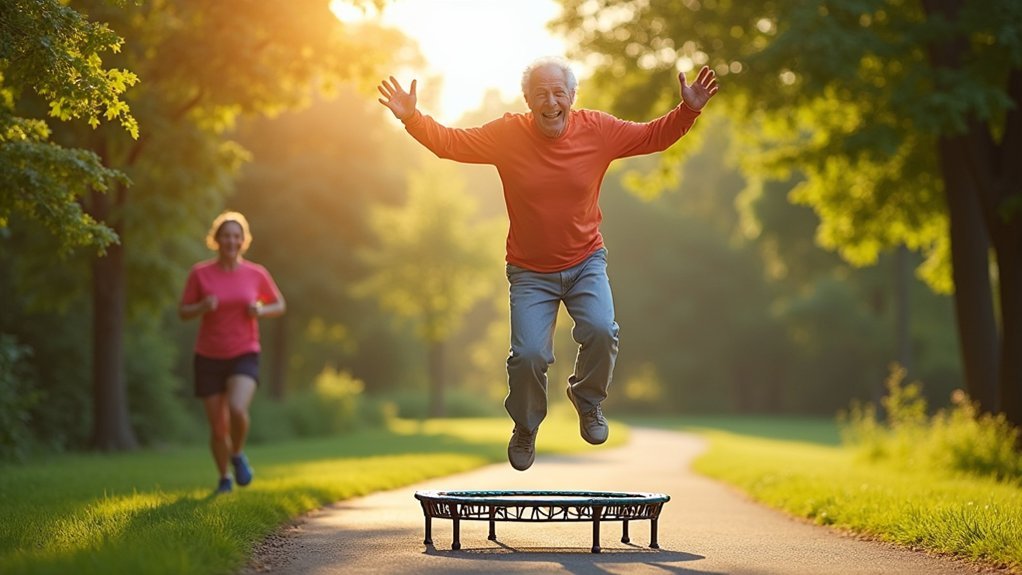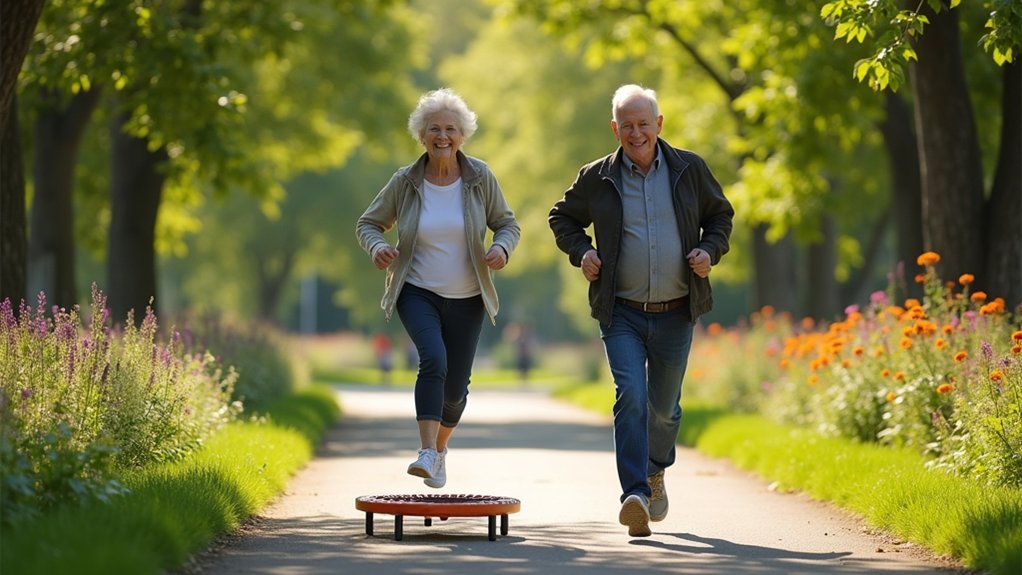Mini-trampolines offer significant advantages over jogging for older adults. You’ll experience 68% more efficient calorie burning with less impact on aging joints. The bouncing motion improves balance, stimulates your lymphatic system, and strengthens bones more effectively than jogging. Your heart benefits equally from both exercises, but rebounding can be done indoors in limited space regardless of weather. The adjustable nature of mini-trampolines makes them adaptable to various health conditions seniors commonly face.
The Joint-Friendly Nature of Mini-Trampolines

When it comes to preserving joint health while staying active, mini-trampolines offer older adults a remarkable advantage over traditional jogging. Unlike hard pavement that sends shock waves through your body, these rebounders absorb impact during your workout, greatly reducing stress on aging joints.
You’ll experience all the cardiovascular benefits of jogging without the associated joint pain. Research shows that bouncing on a mini trampoline isn’t only gentler but also 68% more efficient for calorie burning than running, according to NASA studies.
The gentle bouncing motion actually stimulates joint lubrication, improving flexibility and overall joint health. For those with arthritis or existing joint issues, the low-impact nature of rebounding allows you to safely increase workout intensity without risking injury, making it an ideal alternative to high-impact exercises like jogging.
Impact Analysis: How Jogging Affects Aging Joints
Jogging, while a popular fitness activity, presents specific challenges for adults in their later years. When you run, each step delivers significant impact to your aging joints, particularly in the knees and hips, creating potential for long-term damage and discomfort.
Research shows that this repetitive pounding can worsen existing conditions like arthritis and accelerate joint degeneration. For older adults, these risks often outweigh cardiovascular benefits.
The hard surfaces you encounter while jogging compound this problem, forcing your joints to absorb substantial shock with each stride.
Contrast this with rebounding on mini-trampolines, which offers a low-impact alternative that’s actually 68% more efficient for cardiovascular health according to NASA research.
Cardiovascular Benefits Comparison for Seniors

Your heart’s response to mini-trampolining can match or exceed the benefits of jogging, with NASA research showing rebounding is 68% more efficient for cardiovascular conditioning.
When you bounce regularly, you’ll notice improvements in arterial flexibility that might be harder to achieve through high-impact jogging.
These cardiovascular advantages become especially valuable as you age, offering you comparable heart rate elevation with markedly reduced joint stress.
Heart Rate Response
Although many assume jogging is the gold standard for cardiovascular exercise, mini-trampoline workouts deliver comparable heart benefits for seniors with considerably less impact.
Research shows older adults achieve an average heart rate of 148 bpm during rebounding sessions—equivalent to jogging intensity but without the joint strain.
What’s more impressive is that rebounding is 68% more efficient than running, according to NASA studies.
This means you’ll get superior cardiovascular benefits in less time on a mini-trampoline.
The low-impact nature of rebounding also translates to reduced post-workout soreness, encouraging more consistent exercise habits.
For seniors concerned about maintaining heart health while protecting aging joints, mini-trampolines offer an ideal solution that promotes healthy heart rate responses while minimizing injury risk—a win-win for your cardiovascular fitness goals.
Arterial Stiffness Impact
Beyond heart rate benefits, mini-trampolines offer older adults a powerful weapon against arterial stiffness—a key predictor of cardiovascular disease.
Research demonstrates that regular rebounding exercises markedly improve blood vessel elasticity and enhance overall cardiovascular health.
What makes rebounding particularly valuable is its impressive efficiency—it’s 68% more effective than jogging for cardiovascular improvements, according to NASA research.
This means you’ll achieve better arterial function with less time and effort.
The low-impact nature of mini-trampolines provides these benefits without stressing your joints, unlike jogging which can aggravate existing pain.
You’ll still burn more calories (234 in 30 minutes compared to jogging’s 218) while protecting your joints.
For seniors concerned about heart health, rebounding’s ability to reduce arterial stiffness translates directly to better mobility and lower heart disease risk.
Balance and Fall Prevention Advantages
Mini-trampolines offer you superior balance benefits compared to jogging, as they engage your core muscles while providing a forgiving, low-impact surface.
You’ll strengthen essential lower body muscles on a mini-trampoline, which directly translates to improved stability and coordination in your daily activities.
This improved proprioceptive awareness greatly reduces your fall risk—a vital advantage for maintaining independence as you age.
Balance Stability Benefits
When protecting yourself against falls as you age, few exercises rival mini-trampoline rebounding for balance improvement. Your body’s stability gets a significant boost during these workouts as your muscles constantly adjust to the unstable surface, enhancing your proprioceptive awareness.
Unlike jogging, rebounding delivers these balance benefits with minimal impact on your joints. You’ll notice improved coordination as your core and leg muscles strengthen, directly translating to better stability during everyday activities.
The trampoline’s gentle bouncing motion challenges your equilibrium in a controlled environment, training your body to maintain balance when faced with unexpected movements.
You’re more likely to stick with rebounding exercises because they’re enjoyable, creating a positive cycle of increased practice and enhanced stability—ultimately reducing your fall risk while making fitness feel less like a chore.
Reduced Fall Risk
Falls represent one of the greatest health threats for aging adults, with serious incidents often leading to hospitalization and loss of independence.
Mini-trampolines offer a significant reduced fall risk advantage over jogging by providing a controlled environment to develop your balance before falling becomes a real danger.
The gentle bouncing motion enhances your proprioception—your awareness of body position—while simultaneously improving coordination and motor skills essential for everyday movements.
Unlike jogging’s repetitive impact, rebounding delivers a full-body workout that strengthens core muscles and improves stability with minimal joint stress.
Research confirms that regular mini-trampoline use decreases joint stiffness while boosting confidence in movement.
This combination of physical and psychological benefits creates a positive cycle—better balance leads to more activity, further reducing your fall risk.
NASA Research on Rebounding Efficiency

According to groundbreaking NASA research, rebounding on mini-trampolines delivers 68% more cardiovascular efficiency than traditional jogging exercises. This means you’ll achieve better heart health with less time and effort when you incorporate rebounding into your fitness routine.
What makes this finding particularly valuable for older adults is that rebounding provides these superior cardiovascular benefits without stressing your joints. You’ll experience a thorough low-impact workout that engages multiple muscle groups simultaneously, enhancing your strength and endurance safely.
The research also reveals that participants found rebounding more enjoyable than jogging. You’re more likely to stick with an exercise you actually look forward to doing.
Enjoyment drives consistency—you’ll naturally commit to rebounding because it’s a workout that feels like play.
This combination of efficiency, joint protection, and enjoyment makes rebounding an ideal cardiovascular workout choice for maintaining fitness as you age.
Caloric Burn: Mini-Trampolines vs. Traditional Running
Contrary to what many assume about low-impact exercises, mini-trampolines actually outperform traditional jogging in caloric burn for older adults.
Research demonstrates that a 30-minute rebounding session burns 234 calories for a 128 lb individual, exceeding jogging’s 218 calories in the same timeframe.
The cardiovascular engagement remains comparable between both activities, with heart rates averaging 144-148 bpm.
What’s remarkable is that NASA research confirms rebounding is 68% more efficient than running, making it an ideal option for seniors seeking maximum results with minimal joint stress.
This low-impact nature of trampolining allows you to exercise longer and more frequently without risking injury.
You’ll achieve greater caloric burn while enjoying workouts that can be customized to your personal fitness level—something particularly valuable as you age.
Bone Density Benefits for Aging Adults
As bone density naturally decreases with age, mini-trampolines offer a powerful solution for older adults concerned about osteoporosis.
Research shows that regular rebounding enhances bone mineralization more effectively than jogging—NASA even found it’s 68% more efficient for improving skeletal health.
When you bounce on a mini-trampoline, you’re applying beneficial stress to your bones, triggering growth and strengthening.
This weight-bearing exercise is essential for aging adults who need to maintain skeletal integrity. Competitive trampolinists demonstrate notably higher bone mineral density in their hips and spine compared to non-trampolinists.
You’ll also reduce your fracture risk while using a mini-trampoline, as rebounding not only builds stronger bones but improves your balance—a dual benefit that makes it an ideal exercise choice for preventing osteoporosis.
Accessibility and Space Requirements for Both Activities
You’ll find mini-trampolines incredibly convenient for small living spaces, requiring only a 4-foot area compared to the extensive outdoor terrain needed for jogging.
Most rebounders can be folded and tucked away under beds or in closets when not in use, while jogging demands accessible outdoor paths regardless of weather conditions.
This space-saving advantage makes rebounding particularly attractive for older adults living in apartments or homes with limited room, enabling consistent exercise without leaving your living area.
Space Needs Comparison
When considering exercise options for older adults, the physical space required for each activity can greatly impact accessibility and adherence. Mini-trampolines offer a significant advantage with their compact 40-inch diameter footprint, making them ideal for those with limited mobility or restricted living spaces.
Unlike jogging, which demands open, flat areas like parks or sidewalks, rebounders can fit comfortably in small indoor spaces. You’ll only need enough overhead clearance to bounce safely. This indoor accessibility means you can exercise regardless of weather conditions that might otherwise interrupt a jogging routine.
The storage-friendly nature of mini-trampolines further enhances their practicality—simply tuck them under a bed or into a closet when not in use. For older adults with space constraints, rebounders provide a convenient, year-round exercise solution without traversing outdoor terrain.
Equipment Storage Solutions
Storage practicality often becomes a decisive factor for older adults selecting long-term exercise options. Mini-trampolines offer seniors significant advantages in this regard. Most rebounders are designed with space efficiency in mind, making them ideal for your home workout environment.
Consider these storage benefits for seniors using mini-trampolines:
- Foldable designs allow you to conveniently tuck your trampoline under a bed or inside a closet when not in use.
- Compact 40-inch diameter means you can keep it in a corner of your living room without disrupting your living space.
- Lightweight construction guarantees you won’t strain yourself when moving or storing the equipment.
Unlike jogging which requires no equipment storage, the mini-trampoline’s space-efficient design provides a practical indoor exercise solution when outdoor options are limited or inaccessible.
Setting Up a Safe Rebounding Routine
Safety comes first when establishing your mini-trampoline exercise routine, especially for older adults.
Prioritize safety for seniors when setting up your rebounding routine—your well-being depends on proper precautions.
Begin by placing your rebounder on a flat, obstacle-free surface with enough space around it for safe movement. Before attempting higher jumps, start with light bouncing while keeping your feet firmly on the mat to build confidence and balance.
Select a mini-trampoline with essential safety features, particularly an adjustable padded handlebar that provides support when needed and a stable frame to prevent tipping.
Don’t rush your progress—gradually increase your jumping time by starting with just 5 minutes daily and adding one minute each week until you reach 20 minutes.
Before commencing any rebounding program, consult your healthcare provider to verify this exercise form suits your specific health conditions and fitness level.
Lymphatic System Stimulation in Older Adults
Unlike traditional exercises, rebounding on mini-trampolines offers remarkable benefits for your lymphatic system, especially as you age.
The gentle bouncing motion causes lymphatic valves to open and close rhythmically, increasing circulation by up to 68% – considerably more effective than jogging for older adults.
When you rebound, you’ll experience:
- Enhanced toxin removal as the bouncing motion pumps lymph fluid throughout your body
- Reduced inflammation and swelling in your extremities, a common concern for seniors
- Improved immune function as your lymphatic system clears cellular waste more efficiently
This lymphatic system stimulation through rebounding helps combat fluid retention issues that many older adults face, while being gentler on joints than high-impact activities like jogging.
Mental Health Benefits of Bouncing vs. Running
While physical benefits are often emphasized, the mental health advantages of rebounding on a mini-trampoline can be even more significant for older adults.
When you bounce, your brain releases endorphins similar to jogging, but with added benefits of increased serotonin and oxytocin levels—effectively fighting anxiety and depression symptoms.
Bounce away the blues with trampoline exercise—your brain rewards you with mood-boosting chemicals that traditional workouts can’t match.
You’ll likely find rebounds more enjoyable than jogging, which means you’re more likely to stick with your exercise routine long-term. This consistency is essential for sustained mental health improvements.
For older adults especially, the low-impact nature eliminates the worry about joint pain that often accompanies jogging.
The improved blood circulation from regular trampoline exercise also enhances brain health, potentially boosting cognitive function and reducing your risk of cognitive decline—giving you compelling mental health benefits beyond just physical fitness.
Adapting Exercises for Common Senior Health Conditions
When adapting exercise routines for seniors with health conditions, mini-trampolines offer superior flexibility compared to jogging.
Rebounding’s low-impact nature makes it ideal for those with arthritis or joint pain, while still delivering cardiovascular benefits that are 68% more efficient than jogging.
For specific conditions, consider these modifications:
- Arthritis/Joint Pain: Hold onto a stability bar while rebounding gently, focusing on small bounces that improve circulation without jarring sensitive joints.
- Osteoporosis Risk: Incorporate gentle bouncing sessions to stimulate bone density growth without high-impact stress.
- Balance Concerns: Begin seated on the trampoline, gradually progressing to standing exercises with support nearby to prevent falls.
You’ll find these adaptations allow continued exercise even as health conditions evolve, maintaining fitness while protecting vulnerable areas of your body.
Frequently Asked Questions
Are Mini Trampolines Good Exercise for Seniors?
Yes, mini trampolines are excellent exercise for seniors. You’ll enjoy their low-impact nature that’s gentle on your joints while they improve your balance, circulation, and strength. They’re actually 68% more efficient than running.
Can a 60 Year Old Use a Rebounder?
Yes, you can absolutely use a rebounder at 60. It’s actually ideal for your age group, offering low-impact exercise that protects your joints while improving balance and strength. Start slowly with safety features.
Is 10 Minutes on a Trampoline Equivalent to 30 Minutes of Running?
Based on NASA’s findings that rebounding is 68% more efficient than running, your 10 minutes on a trampoline can provide cardiovascular benefits roughly equivalent to 30 minutes of running while being gentler on your joints.
Who Should Not Use a Mini-Trampoline?
You shouldn’t use a mini-trampoline if you have severe balance issues, recent surgeries, uncontrolled hypertension, osteoporosis, or joint problems. Always consult your doctor first if you’re uncertain about your fitness for rebounding exercises.
In Summary
You’ve now got a complete picture of why mini-trampolines often edge out jogging for seniors. They’ll spare your joints, improve your balance, and boost your cardiovascular health while keeping exercise fun. Whether you’re managing health conditions or seeking better lymphatic flow, rebounding offers an efficient, NASA-backed workout alternative. Start with just a few minutes daily, and you’ll likely notice the difference in how you feel.





Leave a Reply